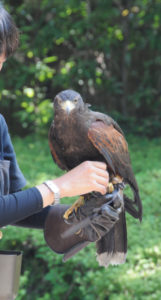Last Saturday, I took the day off to go to Arashiyama in the western part of Kyoto. It once was a kind of country retreat for the city’s aristocrats, and even though distances have shrunk thanks to modern travel, it still takes me more than an hour to get there. That means, I don’t really like to go there – unless there is something very special going on.
 Like a hawk show. The Saga Arashiyama Museum of Arts and Culture is holding a special exhibition at the moment with paintings of birds. And to make things interesting beyond the usual talk of art experts, they invited a falconer to come and show us his hawks.
Like a hawk show. The Saga Arashiyama Museum of Arts and Culture is holding a special exhibition at the moment with paintings of birds. And to make things interesting beyond the usual talk of art experts, they invited a falconer to come and show us his hawks.
First, there was a talk, of course. In Japan, falconry is called takagiri and it goes back as a sport for the nobles to the 4th century, when it was introduced from Korea. Tokugawa Ieyasu was particularly fond of hawking and put together a string of laws to govern its use during the Edo period. After the Meiji Restoration, however, takagiri was mostly discontinued, and today it is practised by a private clubs.
When a hawk is hatched, it takes about two months until it reaches the size of an adult. At this point, the training begins, first with very short sessions of 5 minutes a day, increasing to 10 minutes, 15 minutes… up to 4 hours of training a day. Interestingly, female hawks are larger than male ones, and they are easier to train for some reason. Hawks are flown daily and there is no retirement for them; they have a life span of 20 – 30 years.
Most of the training is based on incentives with food. Unfortunately, I did not quite understand what exactly they are fed, but the falconer stated that it’s not as simple as going to the supermarket and buying meat there. An interesting tidbit is that Japanese falconers fly their birds from the left hand, while in China the right hand is used. Part of it is that most people are right-handed, but part of it is that in Japan, the samurai still needed to be able to draw a sword…
After the talk, we were treated to a hawk show. There were two hawks present, and one of them was flown indoors between two people. After one or two how-to’s, visitors were invited to try themselves (with the help of a falconer, of course). Finally, we went outside for a more authentic experience. This time only the falconers worked with the birds though, but we saw how a hawk would hunt for a flying object, and it is amazing how fast these animals really are.

